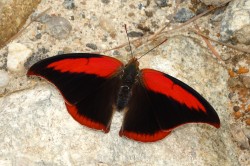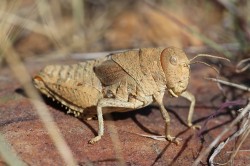Press Release, 10. February 2020
Scientists warn humanity about worldwide insect decline, and suggest ways to recognise
Insect declines and extinctions are accelerating in many parts of the world. With this comes the disappearance of irreplaceable services to humans, the consequences of which are unpredictable. A group of scientists from across the globe including Helmholtz Centre for Environmental Research (UFZ) and German Centre for Integrative Biodiversity Research (iDiv) has united to warn humanity of such dangers. Engaging civil society and policy makers is essential for the future and mutual well-being both of people and insects. In addition to mitigating climate change, an important aspect of the solution involves setting aside high-quality and manageable portions of land for conservation, and transforming global agricultural practices to promote species co-existence.

Photo: Augusto Rosa

Photo: Axel Hochkirch
Humanity is pushing many ecosystems beyond recovery. As a consequence, unquantified and unquantifiable insect extinctions are happening every day. Two scientific papers by 30 experts discuss both the perils and ways to avoid further extinctions, intending to contribute towards a necessary change of attitude for humanity’s own sake.
"It is surprising how little we know about biodiversity at a global level, when only about 10 to 20 per cent of insect and other invertebrate species have been described and named. And of those with a name, we know little more than a brief morphological description, maybe a part of the genetic code and a single site where it was seen some time ago," says Pedro Cardoso, from the Finnish Museum of Natural History, University of Helsinki, Finland.
"Due to this limited knowledge, also within the IPBES Global Assessment we conservatively estimated that around 10 per cent of all insect species are facing extinction within the next decades, if we do not act. Assuming that there are five millions insect species on earth, this means that 0.5 millions are at risk of extinction, which makes half of our total global estimate of species at risk," says co-author Prof. Dr. Josef Settele, from UFZ and iDiv, who also is co-chair of the IPBES Global Assessment.
Habitat loss, pollution - including harmful agricultural practices, invasive species that do not encounter borders, climate change, overexploitation and extinction of dependent species all variably contribute to documented insect population declines and species extinctions.
"With species loss, we lose not only another piece of the complex puzzle that is our living world, but also biomass, essential for example to feed other animals in the living chain, unique genes and substances that might one day contribute to cure diseases, and ecosystem functions on which humanity depends," confirms Cardoso.
The ecosystem functions he mentions include pollination, as most crops depend on insects to survive. Additionally, decomposition, as they contribute to nutrient cycling, as well as many other functions for which we have no technological or other replacement.
The researchers also suggest possible practical solutions based on existing evidence gathered from around the world, which would help to avoid further insect population loss and species extinctions. These include actions such as setting aside high-quality and manageable portions of land for conservation, transforming global agricultural practices to promote species co-existence, and mitigating climate change.
Above all, communicating and engaging with civil society and policy makers is essential for the future and mutual well-being both of people and insects.
"While small groups of people can impact insect conservation locally, collective consciousness and a globally coordinated effort for species inventorying, monitoring and conservation is required for large-scale recovery" says Michael Samways, Distinguished Professor at Stellenbosch University, South Africa.
Ideas to help insects
1. Avoid mowing your garden frequently; let nature grow and feed insects.
2. Plant native plants; many insects need only these to survive.
3. Avoid pesticides; go organic, at least for your own backyard.
4. Leave old trees, stumps and dead leaves alone; they are home to countless species.
5. Build an insect hotel with small horizontal holes that can become their nests.
6. Reduce your carbon footprint; this affects insects as much as other organisms.
7. Support and volunteer in conservation organizations.
8. Do not import or release living animals or plants into the wild that could harm native species.
9. Be more aware of tiny creatures; always look on the small side of life
Publications:
Cardoso, P., Barton, P.S., Birkhofer, K., Chichorro, F., Deacon, C., Fartmann, T., Fukushima, C.S., Gaigher, R., Habel, J.C., Hallmann, C.A., Hill, M.J., Hochkirch, A., Kwak, M.L., Mammola, S., Ari Noriega, J., Orfinger, A.B., Pedraza, F., Pryke, J.S., Roque, F.O., Settele, J., Simaika, J.P., Stork, N.E., Suhling, F., Vorster, C., Samways, M.J. (2020) Scientists’ warning to humanity on insect extinctions. Biological Conservation. DOI https:/doi.org/10.1016/j.biocon.2020.108426
Samways, M.J., Barton, P.S., Birkhofer, K., Chichorro, F., Deacon, C., Fartmann, T., Fukushima, C.S., Gaigher, R., Habel, J.C., Hallmann, C.A., Hill, M.J., Hochkirch, A., Kaila, L., Kwak, M.L., Maes, D., Mammola, S., Ari Noriega, J., Orfinger, A.B., Pedraza, F., Pryke, J.S., Roque, F.O., Settele, J., Simaika, J.P., Stork, N.E., Suhling, F., Vorster, C. & Cardoso, P. (2020) Solutions for humanity on how to conserve insects. Biological Conservation. DOI https:/doi.org/10.1016/j.biocon.2020.108427
More information
About IPBES:
https://www.ufz.de/index.php?de=44469
Further information
Pedro Cardoso
pedro.cardoso@helsinki.fi
Prof. Michael Samways
samways@sun.ac.za
Prof. Dr. Josef Settele
UFZ-Department Community Ecology / iDiv
josef.settele@ufz.de
UFZ press office
Susanne Hufe
Phone: +49 341 6025-1630
presse@ufz.de
In the Helmholtz Centre for Environmental Research (UFZ), scientists conduct research into the causes and consequences of far-reaching environmental changes. Their areas of study cover water resources, ecosystems of the future, environmental technologies and biotechnologies, the effects of chemicals in the environment, modelling and social-scientific issues. The UFZ employs more than 1,100 staff at its sites in Leipzig, Halle and Magdeburg. It is funded by the Federal Government, Saxony and Saxony-Anhalt.
www.ufz.deThe Helmholtz Association contributes to solving major challenges facing society, science and the economy with top scientific achievements in six research fields: Energy; Earth and Environment; Health; Key Technologies; Matter; and Aeronautics, Space and Transport. With some 39,000 employees in 19 research centres, the Helmholtz Association is Germany’s largest scientific organisation.
www.helmholtz.de